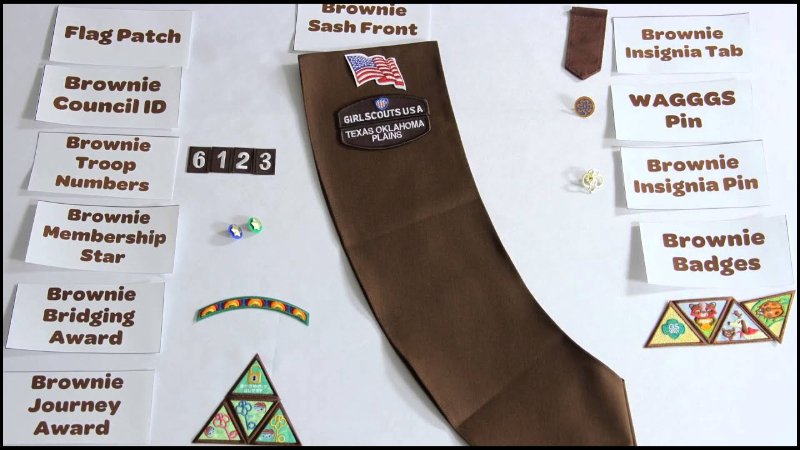Ironing Brownie Patches: Sash Placement and Tips
Is your Brownie bursting with pride over their newly earned badges and patches? Learning how to properly iron on those patches is crucial for creating a sharp, well-maintained Brownie sash that showcases their achievements. This comprehensive guide covers everything from official sash placement guidelines to expert ironing techniques and even troubleshooting common problems. Get ready to transform that sash into a testament to your Brownie’s hard work and dedication!
1. Gathering Your Materials
Before diving into attaching those hard-earned Brownie patches, taking a moment to gather everything will make the whole process smoother and more enjoyable. It’s like setting up your workspace before starting a craft project – having all items readily accessible prevents interruptions and allows focusing on the task at hand.

1.1. Essential Supplies
- Brownie Sash: This is, of course, the foundation for displaying those achievements!
- Brownie Patches: The stars of the show! Ensure that patches have an iron-on backing. This is a heat-activated adhesive layer that will bond the patch to the sash.
- Iron: The essential tool for activating the adhesive.
- Ironing Board: A firm, heat-resistant surface is crucial for effective ironing. A dedicated ironing board is best, but a sturdy table covered with a thick towel can also work. Just make sure it’s heat-resistant surface.
- Pressing Cloth: This is a thin piece of fabric (like a cotton handkerchief, a piece of muslin, or even parchment paper) placed between the iron and the patch. This is incredibly important! It protects both the sash and the patch from direct heat, preventing scorching, melting, or damage to any delicate embroidery.
1.2. Optional Supplies
These items aren’t strictly necessary, but they can make the process easier and more precise:
- Tweezers: Helpful for handling small patches or making fine adjustments to placement without risking finger burns.
- Ruler or Measuring Tape: Useful for ensuring consistent spacing and straight alignment, especially when applying multiple patches.
- Fabric Glue: While this guide focuses on ironing, fabric glue can be a helpful backup if a patch doesn’t adhere completely, or for added reinforcement.
- Sewing Kit: Another option for extra security, especially for patches that might experience a lot of wear and tear. Sewing around the edges provides the most durable attachment.
2. Preparing the Sash and Patch
Before applying any heat, some preparation work will pay off in the long run. Proper setup makes the process smoother and, most importantly, protects the Brownie sash and patches from damage.
2.1. Cleaning the Sash
It might seem like a small detail, but ensuring the sash is clean is very important. Any dirt, dust, or debris on the fabric can interfere with the adhesive bond, potentially causing the patch to detach later. Make sure the sash is completely dry before proceeding to the next step. This ensures the best possible surface for the patch to adhere to.
2.2. Positioning the Patch
This is where some planning comes in. Deciding where to place each patch is part of the fun, and allows some creativity. Take some time to arrange the patches on the sash, considering the overall layout. Should you make sure to follow the Girl Scout uniform guidelines for placement of official insignia, but there’s often room for personalization with fun patches.
Once users are happy with the arrangement, it will be helpful take a photo or make a small mark with a fabric pencil as a reference. Accuracy is key here – once the patch is ironed on, it’s difficult to reposition it without risking damage to the adhesive.
2.3. Preheating the Iron
The correct iron temperature is critical for successful patch application. A setting that’s too low won’t activate the adhesive properly, while a setting that’s too high can scorch the sash or damage the patch. Check the care label on the sash for fabric content, if available.
A medium heat setting (often labeled “synthetic” or “polyester”) is usually a good starting point. However, always make sure the iron’s steam function is turned off. Steam can interfere with the adhesive and prevent a strong bond. A dry iron is essential for this task.

3. Ironing the Patch: Step-by-Step
Now comes the main event – actually attaching the patch! With everything prepared, this part should be straightforward. Follow these steps carefully for the best results:
3.1. Applying the Pressing Cloth
Place the Brownie sash flat on the ironing board. Carefully position the Brownie patch in the desired location, making sure the adhesive side is facing down, touching the sash fabric. Then, and this is crucial, lay the pressing cloth over the patch.
The pressing cloth acts as a protective barrier, distributing the heat evenly and preventing direct contact between the hot iron and the patch or sash. This prevents scorching, melting, or any other damage.
3.2. Ironing the Front of the Patch
With the pressing cloth in place, take the preheated iron (remember, no steam!) and place it directly on top of the pressing cloth, over the area where the patch is located. Apply firm, even pressure. Don’t move the iron around as if ironing a shirt.
Instead, hold it still, pressing down firmly for about 15-20 seconds. This duration allows the heat to penetrate through the pressing cloth and activate the adhesive on the back of the patch, creating a bond with the sash fabric. The key here is steady pressure, not movement.
3.3. Ironing the Back of the Patch
Carefully turn the sash inside out. This allows to apply heat directly to the back of the patch area, further strengthening the adhesive bond. Place the pressing cloth over the back of the patch area even though the patch itself is now face down.
Again, apply the hot iron to the pressing cloth, pressing firmly for another 15-20 seconds. This step ensures that the adhesive is fully activated and fused to the fabric fibers from both sides.
3.4. Cooling and Checking Adhesion
Remove the iron and the pressing cloth. Resist the urge to touch the patch immediately! It’s very important to let the patch cool completely. This allows the adhesive to set and solidify, creating a strong, permanent bond.
Once the patch is cool to the touch (this usually takes a few minutes), gently try to lift one edge of the patch with fingernail or tweezers. If it’s securely attached, it should resist lifting. If any part of the patch feels loose or peels up easily, repeat steps 3.2 and 3.3, focusing on the areas that need more attention.
4. Troubleshooting: What to Do If the Patch Doesn’t Stick
Even with careful preparation and following the steps, sometimes a patch might not adhere perfectly. Don’t worry; this is usually fixable! Here are some common problems and their solutions:
4.1. Insufficient Heat or Pressure
This is the most frequent culprit. If the patch isn’t sticking, it’s possible the iron wasn’t hot enough or firm pressure wasn’t applied during the ironing process. Try increasing the iron’s temperature slightly. Repeat the ironing steps, making sure to apply consistent, firm pressure for the full recommended time.
4.2. Uneven Surface
An uneven ironing surface can prevent uniform heat distribution, leading to weak adhesion in some areas. Make sure to use a firm, flat ironing board or a well-padded, heat-resistant table. If using a makeshift surface, double-check that it’s completely smooth and doesn’t have any bumps or wrinkles that could interfere with the ironing process. A perfectly flat surface is key for even heat and pressure.
4.3. Patch Adhesive Issues
In rare cases, the patch itself might have a faulty adhesive. This is less common, but it can happen. If it has been tried everything else and the patch still refuses to stick, there are a couple of options. Fabric glue can be applied to the back of the patch to reinforce the bond. Alternatively, sewing the patch onto the sash is always a reliable, though more time-consuming, solution.
4.4 Damp Fabric
One of the reasons a patch may not stick could be the presence of moisture. Check if the surface of the sash or the pressing cloth is damp. The adhesive won’t work effectively on a moist surface. Proceed only if the sash and pressing cloth are dry.
5. Alternative Attachment Methods
While this guide focuses on ironing, it’s good to know that there are other ways to attach Brownie patches. These alternatives can be useful if don’t have an iron, if dealing with a delicate fabric, or if simply prefer a different method.
5.1. Sewing the Patch
This is the most traditional and arguably the most durable method. Sewing the patch onto the sash creates a very secure attachment that can withstand a lot of wear and tear. It’s a great option for patches that will be on the sash for a long time, or for areas that get a lot of friction. However, it does require some basic sewing skills and takes more time than ironing.
5.2. Using Fabric Glue
Fabric glue is a convenient, no-sew option. It’s relatively easy to use and can create a strong bond, especially for smaller patches. However, it’s important to choose a fabric glue that’s specifically designed for fabric and that’s washable.
Some fabric glues can be messy or can stiffen the fabric, so it’s always a good idea to test it on a small, inconspicuous area first. Also, keep in mind that fabric glue may not be as durable as sewing, especially with frequent washing.
6. Caring for Your Brownie Sash
Once all those hard-earned patches are securely attached, taking good care of the Brownie sash will keep it looking its best for years to come. Proper care and maintenance will preserve not only the sash itself but also the integrity of the attached patches.

6.1 Washing the Sash
Frequent washing can weaken the adhesive bond of iron-on patches, so try to spot-clean the sash whenever possible. If a full wash is necessary, hand-washing is the gentlest option. Use cold water and a mild detergent, and avoid harsh scrubbing or twisting.
If using a washing machine, select the delicate or gentle cycle, also with cold water and a mild detergent. Turning the sash inside out before washing can provide extra protection for the patches. It’s best to air-dry the sash, either by laying it flat or hanging it up. Avoid using a machine dryer, as the high heat can damage the patches or the sash fabric.
6.2 Storing the Sash
Proper storage helps prevent wrinkles and damage to the patches. When not in use, perhaps in a drawer or on a shelf, avoiding folding it directly on top of the patches. Alternatively, hanging the sash on a hanger is a good option.
Avoid storing the sash in direct sunlight or in a damp environment, as these conditions can cause fading or mildew. The goal is to keep the sash clean, dry, and protected from any unnecessary stress.
7. Related Questions
Here are some common questions that often come up regarding Brownie patches and sashes:
7.1 Can I re-iron a patch that’s starting to peel?
Yes, often can! Follow the original ironing instructions (pressing cloth, firm pressure, correct heat), focusing on the areas that are lifting. If that doesn’t work, consider using fabric glue or sewing for reinforcement.
7.2 What if I accidentally scorch the sash while ironing?
Unfortunately, scorch marks are usually permanent. Prevention is key! Always use a pressing cloth and the correct iron temperature. If a scorch mark does occur, could try to cover it with a strategically placed patch, but there’s no guarantee it will completely hide the damage.
7.3 Can I use iron-on patches on other fabrics besides the sash?
Yes, iron-on patches can generally be applied to a variety of fabrics, but always check the fabric care label first. Avoid using iron-on patches on delicate fabrics like silk or rayon, or on fabrics with a low melting point.
7.4 Where can get information of Girl Scout?
It is recommended searching for keyword “Girl Scout” to find information from official website.
7.5 Is there any other way instead of using iron for patches?
Yes. You can refer to other methods as mentioned above
Read more:
Ironing on Brownie patches is a rewarding way to celebrate achievements and personalize the sash. By gathering the right materials, preparing the sash and patch carefully, and following the step-by-step ironing instructions, you can create a lasting display of accomplishments. Remember the importance of the pressing cloth, applying firm, even pressure, and allowing the patch to cool completely.
And don’t forget that there are alternative attachment methods like sewing or fabric glue if ironing isn’t the best option. With a little care and attention, that Brownie sash will be a cherished keepsake for years to come, representing hard work, dedication, and a whole lot of fun!






















